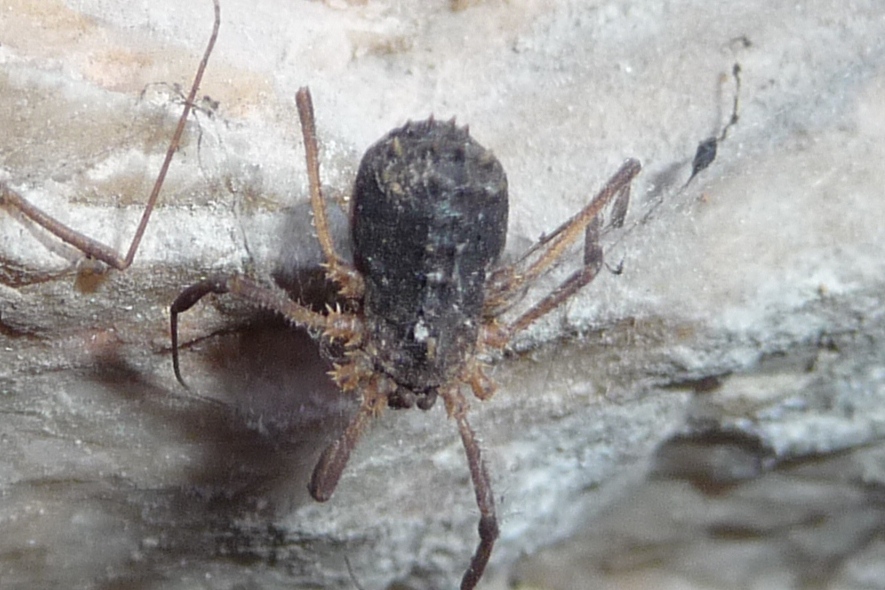|
|
|
|
|
Galleria Tassonomica
di
Natura Mediterraneo
|
 ATTENZIONE! Con tutti gli opilionidi è estremamente importante vedere l'oculario e la zona di fronte ad esso. Questo è vero in particolare per gli opilionidi a zampe corte nei quali il tridente è una caratteristica distintiva. ATTENZIONE! Con tutti gli opilionidi è estremamente importante vedere l'oculario e la zona di fronte ad esso. Questo è vero in particolare per gli opilionidi a zampe corte nei quali il tridente è una caratteristica distintiva.
Si dovrebbe misurare la lunghezza del corpo. Se è possibile scattare fotografie prese dall'alto e di lato. Naturalmente non dovrebbe mancare una semplice foto dorsale. Anche se sono la caratteristica più notevole degli opilionidi, le zampe possono essere ignorate senza problemi perché non hanno virtualmente alcun ruolo nella determinazione.
Per la maggior parte degli Opiliones si arriva ad una determinazione già con le foto. Le eccezioni sono Nemastomatidae ('i piccoli neri') e soprattutto Trogulidae, per i quali è meglio l'analisi del DNA.
|
|
| Autore |
 Discussione Discussione  |
|
|
fern
Utente Senior
   
Città: Vicenza

2376 Messaggi
Flora e Fauna |
|
|
Lars Friman
Utente Senior
   
Città: D-14806 Bad Belzig

680 Messaggi
Flora e Fauna |
 Inserito il - 10 gennaio 2016 : 21:20:41 Inserito il - 10 gennaio 2016 : 21:20:41


|
Moin fern,
well it took some time to ID the speciment. But now I think
we have it 100%.
So it is a Phalangiidae and (subfam.) Sclerosomatinae (see Martens 1978:376-377). The speciment does not have the chracteristic dopple-horn in front of the eyes (Homanolotus), so it belongs to the genus Astrobunus. After the key in Martens (1978:381)the speciment has femura with two dorsal rows of spines, so it can only be a.m.o.: A. helleri or A. kochi. The morphological differenz (see also Martens 1978: Abb. 736-746) between A. helleri and A. kochi is, that A. kochi should have a third row of thin spines between the already mentioned two rows. Your speciment does not show the third row (or I can not see it). Moreover A. helleri can normaly been found mostly north of the river Po (NE, e.g. in Trentino, see Martens 1978: map/App. 756.), A. kochi more near to the med.terr.see and on the apennin half island.
OK, something against that?
Greetings Lars Friman |
|
 |
|
|
fern
Utente Senior
   
Città: Vicenza

2376 Messaggi
Flora e Fauna |
 Inserito il - 10 gennaio 2016 : 22:07:27 Inserito il - 10 gennaio 2016 : 22:07:27


|
A real detective work! I add my last picture with a different view of the spines, in case it helps.
Fig. 3

240,96 KB
For the rest, I observe that Ala is in Trentino: Lat. 45.76°, Long. 11.00°. 
fern |
 |
|
|
vladim
Moderatore trasversale
    

Città: Milano
Prov.: Milano
Regione: Lombardia

34172 Messaggi
Tutti i Forum |
 Inserito il - 11 gennaio 2016 : 06:40:54 Inserito il - 11 gennaio 2016 : 06:40:54


|
In FNM Gallery, the genus Astrobunus belongs to
the Sclerosomatidae family.
  |
 |
|
|
Lars Friman
Utente Senior
   
Città: D-14806 Bad Belzig

680 Messaggi
Flora e Fauna |
 Inserito il - 12 gennaio 2016 : 17:05:36 Inserito il - 12 gennaio 2016 : 17:05:36


|
Moin vladim,
as I wrote before, the connection of the species to the family or
subfamily is only a matter of the autor. If the family of Astrobunus
in FNM is Sclerosomatidae, then I correct the name. OK
Lars Friman |
|
 |
|
|
Lars Friman
Utente Senior
   
Città: D-14806 Bad Belzig

680 Messaggi
Flora e Fauna |
 Inserito il - 12 gennaio 2016 : 17:16:08 Inserito il - 12 gennaio 2016 : 17:16:08


|
CORRECTION
the species A. helleri belongs after FNM to the family of Sclerosomatidae and there to the subfamilie Sclerosomatinae :-)
Lars Friman |
|
 |
|
| |
 Discussione Discussione  |
|
|
|
 Natura Mediterraneo Natura Mediterraneo |
© 2003-2024 Natura Mediterraneo |
 |
|
Leps.it | Herp.it | Lynkos.net
|

 Forum
|
Registrati
|
Msg attivi
|
Msg Recenti
|
Msg Pvt
|
Utenti
|
Galleria |
Map |
Forum
|
Registrati
|
Msg attivi
|
Msg Recenti
|
Msg Pvt
|
Utenti
|
Galleria |
Map |